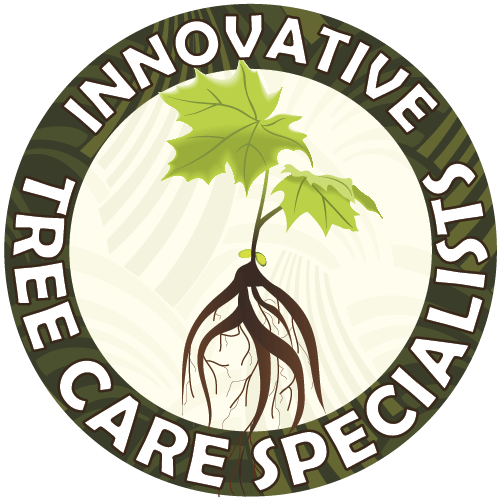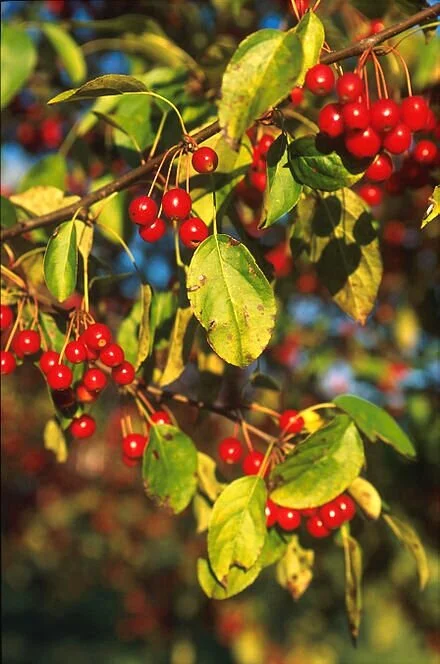Apple Scab
Apple scab is a fungal disease that primarily affects both ornamental and fruit trees in the rose family, such as crabapple, apple, and hawthorn trees. It’s a treatable disease, even after signs are apparent, but proper long term care is vital to the health of your tree. Apple scab is one of the most common diseases to affect apple and crabapple trees in the Midwest.
Apple Scab Signs & Symptoms
Apple scab causes unsightly lesions on leaves and can even lead to reduced production of fruit. Signs of infection are generally seen on leaves first, in the form of relatively circular spots of olive, brown, or black coloring. The size of the spots varies, but severe disease can cause larger lesions or significant leaf dropping as the condition progresses. If it persists year after year, significant leaf loss can cause long term damage.
To identify Apple Scab, look for velvet-like spots with fringed borders; often of olive or brown color, and up to a half inch in diameter. The spots grow larger and darker as the condition progresses. These lesions are particularly prone to forming along the veins of leaves. Trees riddled with apple scab spots may drop a significant portion of their leaves by mid-summer. Infected fruit is distinguished by brownish, corky spots, or by cracks and deformation, if the fruit was very young when it became infected.
How Apple Scab Spreads
Spores of the Apple Scab fungus (Venturia inaequalis) spread by wind, in spring, from the fallen leaves of trees infected in the previous season. The fungus grows on fallen leaves through the winter, only to shoot its spores into the air when spring arrives. Splashing rain or irrigation can also spread the disease to other trees, as the spores disperse throughout the canopy of neighboring trees.
Once the spores have landed on a tree’s leaves, flowers, or fruit, they need several hours of sustained moisture to develop into an infection. If infection settles in, affected spots can begin producing more spores within one to two weeks. This infection cycle can repeat itself numerous times through the season, so long as moist conditions exist. Because Apple Scab requires sustained moisture, it spreads best in the rainy months of spring and early summer.
Treating Apple Scab
Apple Scab can be managed with timely and targeted use of sprayed fungicides. Fungicides won’t cure affected trees, but they can prevent new spots from forming on other trees. Spraying of fungicides should occur in spring, as new leaves form, to prevent them from being affected by Apple Scab, especially if there is a history of the disease in neighboring trees.
Wait until the following season, after leaves have dropped, to treat trees already showing symptoms. It’s important to remove fallen leaves from affected trees to prevent the spores from continuing to spread. It can take up to three years to get Apple Scab under control with multiple or severe infections.
There are numerous fungicide products on the market, but it’s important to use the appropriate formula for your tree. Fungicides, insecticides, miticides, and all-purpose sprays are widely available for purchase, but improper application of any of these can cause damage to your tree or the surrounding ecosystem. We’re happy to consult on any affected trees you may have to help determine the best course of action for limiting spread among your trees.
Preventing Apple Scab
The most effective way to prevent Apple Scab among your trees is to plant disease-resistant varieties. Additionally, it’s imperative to clean up fallen leaves each season so the fungus can’t re-infect other trees in the spring. These leaves should be burned, buried, or composted, so they can’t continue to spread fungal spores.
Proper planting and pruning practices are also effective tools for preventing Apple Scab. Overcrowded trees can facilitate spread of spores, so ensure adequate space between trees. When planting, use expected size of the mature tree as a guide for spacing, rather than the size of the young tree. Since Apple Scab infections require several hours of sustained moisture, pruning branches to allow for better airflow. As air moves between leaves and branches, moisture evaporates, making it more difficult for infections to develop.
Hiring an Expert to Treat Apple Scab
Working with tree care experts can provide streamlined practices and solutions. Innovative Tree Care Solutions professionals can provide a holistic approach to identifying, treating, and preventing Apple Scab infections among your trees. Contact us to arrange a consultation.
Sources:
University of Minnesota Extension
University of Wisconsin Extension


